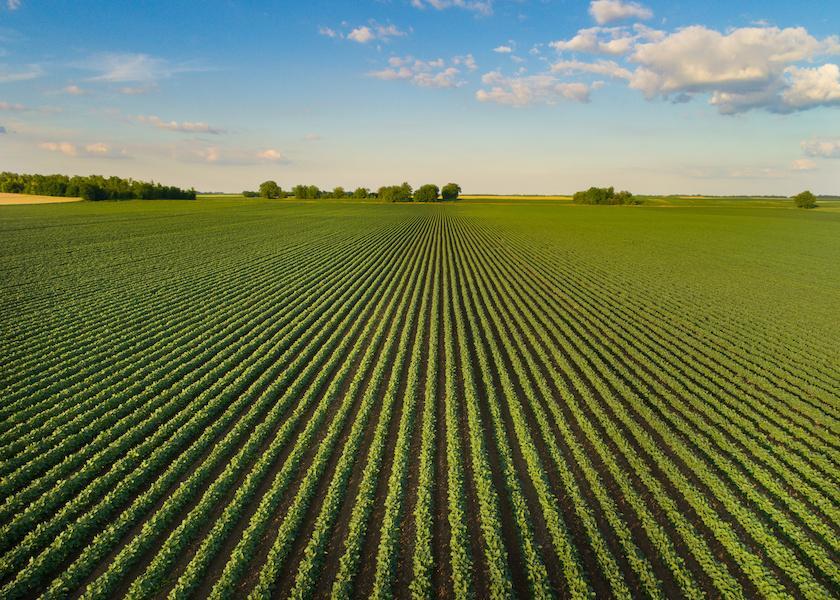A judicial ruling has determined that “Gruyere” is a generic style of cheese that can come from...
25 million Acres at Stake Amid China Trade Tensions

It has previously been noted that U.S. ag exports have struggled in recent years, but that stakes were high for U.S. agriculture as more than one-third of primary crops were directly linked to exports. The landscape is ever-changing, but tensions with China have escalated considerably. Both countries have imposed steep import tariffs (>100%) targeted at each other. U.S. agriculture is effectively locked out of the market at those levels, given that global supplies are sufficient. What are the implications for U.S. producers?
25 million acres
Figure 1 reports that 70 million acres of U.S. crop production are directly linked to exports. To be clear, this is a conservative estimate as the indirect trade of U.S. crop production – such as soybean meal or meat exports – would push the measure even higher.
As expected, China’s crop purchases have increased since the early 2000s. Between 2020 and 2021, China purchased an average of 31 million acres worth of U.S. crops. Activity in 2023 and 2024 fell to nearly 25 million acres worth.
While not shown, it is no surprise that 80% of those China-bound acres are soybeans.
How much is 25 million acres worth of production? It’s more than any single state produces. In March, the USDA reported just a handful of states – Illinois (22.9 million), Iowa (24.3 million), Kansas (23.4 million), and North Dakota (23.0 million) – would have total acres (principal acres) approaching the magnitude. Alternatively, in 2019, prevented planting hit a record of 19 million acres.

Figure 1. Estimate of U.S. primary crop exports, acres worth. Total and China, 1967-2024. Data source: USDA FAS and AEI.ag calculations.
35% of U.S. crop exports
For a slightly different perspective, Figure 2 shows China’s share of U.S. crop exports. In 2024, activity was 34%. This will be a helpful starting point for those wanting to quantify the magnitude of any effects. In 2022, when trade activity was stronger, the share peaked at 40%.
Figure 2 also provides historical context. Before 2000, China accounted for 5% to 10% of U.S. ag exports, sometimes even less. Between 2000 and 2010, the share jumped to more than 35%. Since 2010, China’s activity has been largely flat (also visible in Figure 1). While beyond the scope of this article, the implications are that China’s growth hasn’t been as evident for U.S. exports over the last 10 to 15 years.
The final consideration is the dip during the first trade war. On an acre-basis, activity fell to 8.1 million, the lowest level since 2002. On a percentage basis, China’s purchases accounted for around 11% of these crop exports.

Figure 2. China’s share of U.S. primary crop exports, 1967-2024. Data source: USDA FAS and AEI.ag calculations.
Wrapping it up
For a few months, the brunt of China’s retaliatory tariffs will be hard to notice, given the seasonal purchases of soybeans. However, duration is always important in trade disputes. The longer China’s retaliatory tariffs remain in place, the more pressing the lost 25 million acres of trade will become. The first support to come will likely be the potential for ad hoc trade assistance. In the longer run, attention would likely focus on building ending stocks and strategies for addressing burdensome supplies.
The good news is that most U.S. ag exports – 49 million acres worth – have benefited from reduced tensions.
EDITOR’S TAKE:
This article provides a very clear picture of just how important exports are for U.S. agriculture and how one importing country, China, dominates the discussion over tariffs. We could argue until the cows come home about the efficacy of tariffs, but it is important to note that the U.S. is food independent and China is not. Can they find alternate sources of supply – yes, to some extent, but the quality will not be as high and the relative price may not be as good, dependent upon the value of their currency compared with the U.S. dollar. That said, there is clearly a lot at stake in the negotiations with China and farmers/ranchers are in the crosshairs, just as they were during the first Trump administration. The ultimate question is how long will this battle linger? But once again, as a reminder, farm income during that period was the highest in history. Farmers/ranchers are part of our national security interest and the government will ensure their well-being. Be sure your inventory is on AgTruckTrader.com® because one way or another, farmers/ranchers will have income to spend on new or qualified used trucks and SUV’s.







